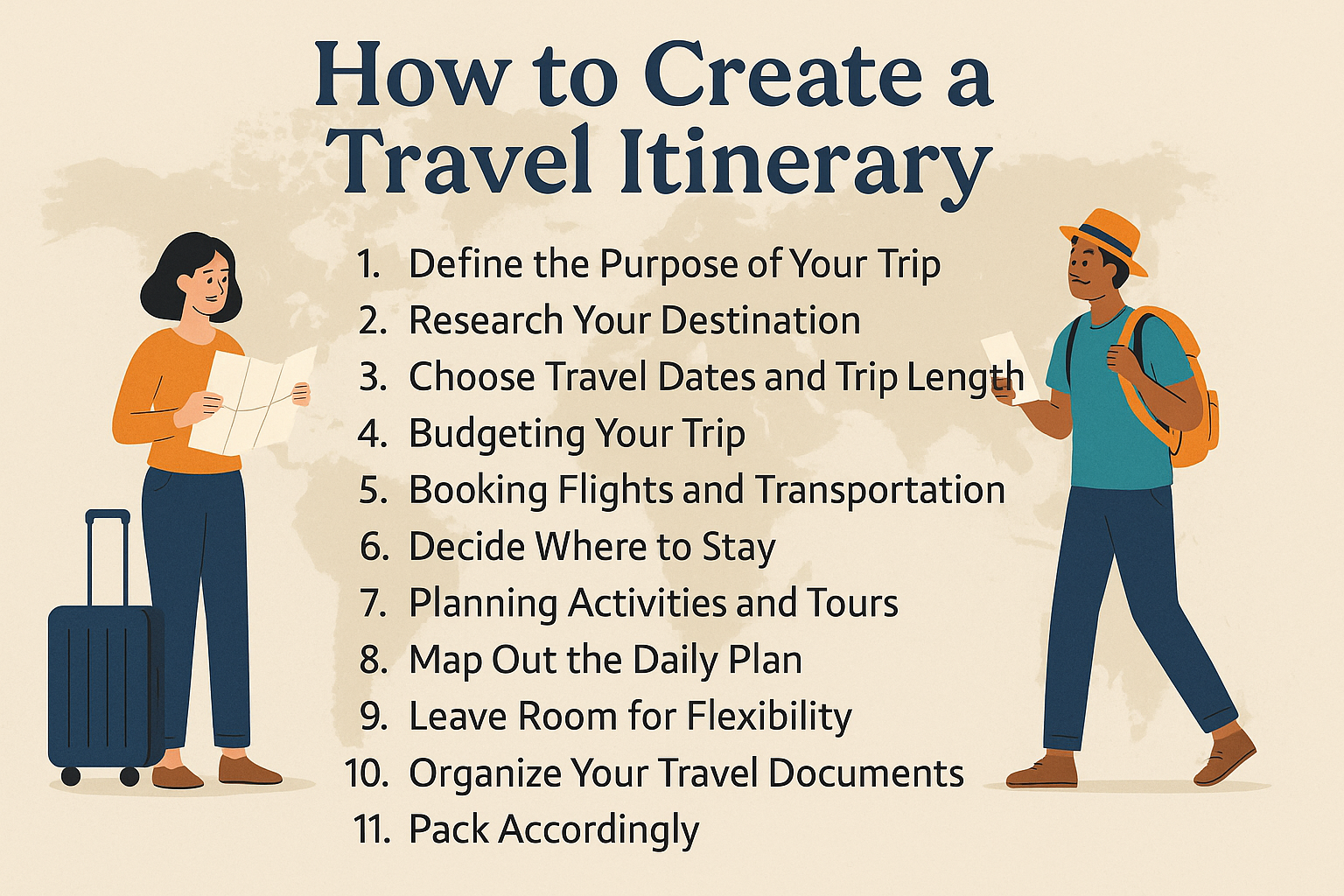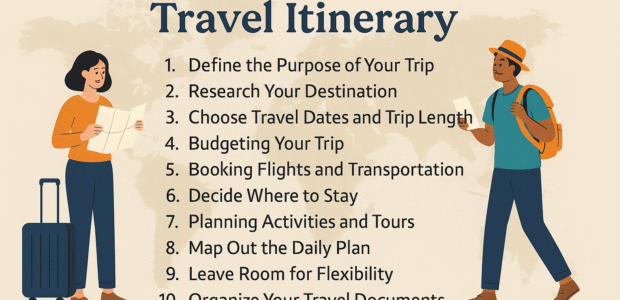
Creating a travel itinerary can be the difference between a chaotic journey and a smooth, unforgettable travel experience. If you’ve ever asked yourself how to create a travel itinerary that works, this comprehensive guide will walk you through the process step by step. From selecting the right destinations to coordinating your transportation and sightseeing plans, we’ll help you create a smart and flexible travel itinerary that suits your travel style.
And if you’re still figuring out where to go, you might want to check this guide on how to choose the best travel destination to start with clarity.
Table of Contents
-
Why You Need a Travel Itinerary
-
Step 1: Define the Purpose of Your Trip
-
Step 2: Research Your Destination
-
Step 3: Choose Travel Dates and Trip Length
-
Step 4: Budgeting Your Trip
-
Step 5: Booking Flights and Transportation
-
Step 6: Decide Where to Stay
-
Step 7: Planning Activities and Tours
-
Step 8: Map Out the Daily Plan
-
Step 9: Leave Room for Flexibility
-
Step 10: Organize Your Travel Documents
-
Step 11: Pack Accordingly
-
Tools and Apps to Create a Travel Itinerary
-
Sample Travel Itinerary Templates
-
Final Tips for a Perfect Itinerary
-
FAQs
Why You Need a Travel Itinerary
You may be tempted to ‘go with the flow’ on your vacation, but trust us — a good travel itinerary helps you:
-
Stay on budget
-
Avoid wasting time
-
Maximize sightseeing
-
Keep transportation and activities well-coordinated
-
Reduce stress
Creating a well-thought-out itinerary doesn’t mean you’ll be boxed into a rigid schedule. Instead, it gives you structure and control while allowing flexibility when needed.
Step 1: Define the Purpose of Your Trip
Before diving into the logistics, ask yourself why you’re taking this trip:
-
Are you going to relax on a beach?
-
Are you seeking an adventurous experience?
-
Is it a romantic escape or a family getaway?
-
Are you a solo traveler exploring new cultures?
Your purpose will define your pace, destinations, budget, and even the best time to go.
Step 2: Research Your Destination
Once you know your “why,” it’s time to figure out the “where.” If you haven’t picked a destination yet, don’t worry — use this helpful guide to choose your travel destination for inspiration.
When researching a destination:
-
Understand visa requirements
-
Check the best time to visit (weather, festivals, safety)
-
Learn about local customs
-
Look up average costs for accommodations, meals, and activities
-
Search for offbeat experiences
Pro Tip: Use trusted platforms like Viator to discover verified tours and activities in your chosen destination.
Step 3: Choose Travel Dates and Trip Length
This is one of the most important parts of your itinerary. Your travel dates affect:
-
Flight prices
-
Accommodation availability
-
Local events and crowd levels
-
Weather and seasonal activities
When deciding how long to travel, consider:
-
How many vacation days you can take
-
How far you’re traveling (don’t spend half your trip on flights)
-
How much you want to see vs. how much downtime you need
Create a skeleton timeline with travel days marked to visualize how much time you’ll actually spend at your destination.
Step 4: Budgeting Your Trip
Budgeting should be one of the first steps in your planning. Create a realistic daily budget that includes:
-
Flights
-
Accommodation
-
Food and drinks
-
Transportation
-
Activities and entrance fees
-
Souvenirs and extras
-
Travel insurance
Tip: Use travel budget calculators or spreadsheet templates. Be generous with your contingency fund — unexpected expenses always pop up.
Step 5: Booking Flights and Transportation
Once your destination and dates are fixed, start looking for flights early. Use tools like:
-
Google Flights
-
Skyscanner
-
Kayak
Look for transportation options within the destination as well. Do you need:
-
A rental car?
-
Trains?
-
Local buses or metros?
-
Airport transfers?
Don’t forget to sync transport times with check-in and activity schedules.
Step 6: Decide Where to Stay
Choosing the right accommodation is crucial. Look for:
-
Proximity to attractions or public transport
-
Safety and reviews
-
Amenities (Wi-Fi, breakfast, family-friendliness)
-
Flexibility in booking and cancellation
Types of stays include:
-
Hotels
-
Vacation rentals (Airbnb, Vrbo)
-
Hostels
-
Boutique inns
-
Resorts
Plot your accommodations on a map to optimize travel time to activities.
Step 7: Planning Activities and Tours
This is the fun part! Make a list of must-see sights and bucket-list experiences. Then group them by:
-
Location (so you’re not zigzagging across town)
-
Opening hours
-
Duration
-
Priority (must-do vs. optional)
Pro Tip: Use Viator to book guided tours, skip-the-line tickets, and local cultural experiences in advance.
Don’t overpack your days. 2-3 main activities per day are often enough.
Step 8: Map Out the Daily Plan
Use tools like Google My Maps or Rome2Rio to visually map your trip. A sample day in your itinerary might look like:
Day 3 – Rome, Italy:
-
8:00 AM – Breakfast near hotel
-
9:00 AM – Colosseum guided tour
-
12:30 PM – Lunch at Trattoria al 42
-
2:00 PM – Roman Forum
-
5:00 PM – Free time
-
7:00 PM – Cooking class via Viator
Include notes for:
-
Reservations
-
Ticket numbers
-
Entry times
-
Travel time between spots
Step 9: Leave Room for Flexibility
Even the best-laid plans can go sideways. Add buffer time between activities and leave one day or half-day free in your itinerary for:
-
Rest
-
Shopping
-
Exploring
-
Contingency for delays or missed events
Your itinerary should be a guide, not a prison schedule.
Step 10: Organize Your Travel Documents
Keep digital and hard copies of:
-
Flight tickets
-
Hotel reservations
-
Activity confirmations
-
Passports and IDs
-
Travel insurance
-
Visa documents
Use travel apps like TripIt or Google Drive to store and access everything in one place.
Step 11: Pack Accordingly
Once your itinerary is set, packing becomes easier. Consider:
-
Climate and weather forecast
-
Dress codes at cultural sites
-
Activity-specific gear (e.g., hiking shoes, snorkels)
-
Tech and chargers
-
Medications and first aid
Make a packing checklist tailored to your itinerary.
Tools and Apps to Create a Travel Itinerary
These tools simplify travel planning:
-
TripIt – Automatically creates itineraries from booking emails
-
Google Sheets – Great for custom planning
-
Roadtrippers – Perfect for planning road trips
-
Sygic Travel – Interactive maps and activity suggestions
-
Google Maps – Custom location lists and saved pins
-
Viator – Discover and book tours, activities, and skip-the-line experiences
Sample Travel Itinerary Templates
Here are two examples for reference:
Sample 1: 5-Day Paris Itinerary
-
Day 1: Arrival, Eiffel Tower sunset visit
-
Day 2: Louvre, Seine River cruise (via Viator)
-
Day 3: Versailles day trip
-
Day 4: Montmartre, food tasting tour
-
Day 5: Shopping and departure
Sample 2: 7-Day Japan Itinerary (Tokyo, Kyoto, Osaka)
-
Day 1–2: Tokyo sightseeing
-
Day 3: Travel to Kyoto, temple visits
-
Day 4: Bamboo Forest, cultural tour
-
Day 5: Nara day trip
-
Day 6: Osaka and Dotonbori
-
Day 7: Departure
Final Tips for a Perfect Itinerary
-
Print your itinerary for backup
-
Share your plan with family or a friend
-
Check for any festivals, strikes, or closures
-
Always have offline maps downloaded
-
Use Viator for easy booking and confirmation
-
Don’t forget downtime – it’s your vacation!
FAQs: How to Create a Travel Itinerary
Q1: How far in advance should I plan a travel itinerary?
Ideally, start 2–3 months in advance for international trips. This allows time for visa applications, better flight deals, and tour bookings.
Q2: Is there an app that can create my itinerary for me?
Yes, TripIt and Sygic Travel are great apps. However, for a personalized touch, manual planning with tools like Google Sheets and Viator is best.
Q3: Can I travel without an itinerary?
Yes, but it increases the chance of missing out on top sights or overspending. A flexible itinerary ensures balance and better time management.
Q4: What if something on my itinerary goes wrong?
Stay flexible. Keep emergency contacts, cancellation policies, and alternatives noted in your plan.
Conclusion
Now that you know exactly how to create a travel itinerary, it’s time to start planning your dream adventure. Whether you’re exploring the canals of Amsterdam, diving into Tokyo’s neon chaos, or relaxing on the beaches of Bali, a well-planned itinerary enhances your experience from start to finish.
Explore curated experiences, tours, and local adventures using Viator, trusted by millions of travelers worldwide.
And don’t forget to start with the basics by reading our guide on how to choose the best travel destination to make your journey meaningful from the very first step.

